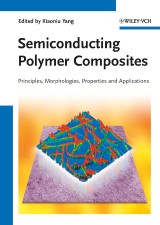Details

Semiconducting Polymer Composites
Principles, Morphologies, Properties and Applications1. Aufl.
|
187,99 € |
|
| Verlag: | Wiley-VCH |
| Format: | |
| Veröffentl.: | 07.10.2012 |
| ISBN/EAN: | 9783527648719 |
| Sprache: | englisch |
| Anzahl Seiten: | 562 |
DRM-geschütztes eBook, Sie benötigen z.B. Adobe Digital Editions und eine Adobe ID zum Lesen.
Beschreibungen
The first part of Semiconducting Polymer Composites describes the principles and concepts of semiconducting polymer composites in general, addressing electrical conductivity, energy alignment at interfaces, morphology, energy transfer, percolation theory and processing techniques. In later chapters, different types of polymer composites are discussed: mixtures of semiconducting and insulating or semiconducting and semiconducting components, respectively. These composites are suitable for a variety of applications that are presented in detail, including transistors and solar cells, sensors and detectors, diodes and lasers as well as anti-corrosive and anti-static surface coatings.
PREFACE <br> <br> SOLUBILITY, MISCIBILITY, AND THE IMPACT ON SOLID-STATE MORPHOLOGY <br> Introduction <br> General Aspects<br> Solubility, Solvents, and Solution Formulations <br> Miscibility<br> Conclusions <br> <br> NANOSCALE MORPHOLOGICAL CHARACTERIZATION FOR SEMICONDUCTIVE POLYMER BLENDS<br> Introduction <br> The Importance of Morphology Control <br> The Classic Blend: MDMO-PPV/PCBM as a Model for an Amorphous Donor System<br> Intermezzo: Morphology Imaging with Scanning Transmission Electron Microscopy <br> Volume Characterization of the Photoactive Layer: Electron Tomography <br> Measuring Nanoscale Electrical Properties: Conductive AFM<br> Current Progress and Outlook<br> <br> ENERGY LEVEL ALIGNMENT AT SEMICONDUCTIVE POLYMER INTERFACES: CORRELATING ELECTRONIC ENERGY LEVELS AND ELECTRICAL CONDUCTIVITY <br> Introduction <br> General View of Electronic Structure of Organic Solids <br> Experimental Methods<br> Valence Electronic Structure of Organic Semiconductors: Small Molecules<br> Valence Electronic Structure of Polymers <br> Role of the Interface Dipole Layer: Its Impact on the Energy Level Alignment<br> Future Prospects<br> <br> ENERGY AND CHARGE TRANSFER <br> Introduction <br> Energy Transfer <br> Charge Transfer in Polymer/Fullerene Composites <br> <br> PERCOLATION THEORY AND ITS APPLICATION IN ELECTRICALLY CONDUCTING MATERIALS<br> Introduction<br> Lattice Percolation <br> Continuum Percolation <br> Percolation Behavior When the Interparticle Conduction Is by Tunneling <br> The Structure of Composite Materials<br> The Observations and Interpretations of the s(x) Dependence in Composite Materials <br> Summary and Conclusions <br> <br> PROCESSING TECHNOLOGIES OF SEMICONDUCTING POLYMER COMPOSITE THIN FILMS FOR PHOTOVOLTAIC CELL APPLICATIONS<br> Introduction <br> Optimization of Bulk Heterojunction Composite Nanostructures <br> Fabrication of Sub-20 nm Scale Semiconducting Polymer Nanostructure <br> Conclusions<br> <br> THIN-FILM TRANSISTORS BASED ON POLYTHIOPHENE/INSULATING POLYMER COMPOSITES WITH ENHANCED CHARGE TRANSPORT <br> Introduction <br> Fundamental Principle and Operating Mode of OTFTs <br> Strategies for Preparing High-Performance OTFTs Based on Semiconducting/Insulating Blends <br> Blend Films with Vertical Stratified Structure <br> Blend Films with Embedded P3HT Nanowires <br> Conclusions and Outlook<br> <br> SEMICONDUCTING ORGANIC MOLECULE/POLYMER COMPOSITES FOR THIN-FILM TRANSISTORS <br> Introduction <br> Unipolar Films for OFETs <br> Polymer/Fullerene Ambipolar OFETs<br> Conclusions <br> <br> ENHANCED ELECTRICAL CONDUCTIVITY OF POLYTHIOPHENE/INSULATING POLYMER COMPOSITE AND ITS MORPHOLOGICAL REQUIREMENT <br> Introduction <br> Phase Evolution and Morphology <br> Enhanced Conductivity of Conjugated Polymer/Insulating Polymer Composites at Low Doping Level: Interpenetrated<br> Three-Dimensional Interfaces <br> Conductivity of Semiconducting Polymer/Insulating Polymer Composites Doped by Molecular Dopant<br> Mechanisms for the Enhanced Conductivity/Mobility <br> Perspective <br> <br> INTRINSICALLY CONDUCTING POLYMERS AND THEIR COMPOSITES FOR ANTICORROSION AND ANTISTATIC APPLICATIONS<br> ICPs and Their Composites for Anticorrosion Application<br> Antistatic Coating<br> Summary <br> <br> CONJUGATED?INSULATING BLOCK COPOLYMERS: SYNTHESIS, MORPHOLOGY, AND ELECTRONIC PROPERTIES<br> Introduction <br> Oligo- and Polythiophene Rod?Coil Block Copolymers <br> Poly(p-phenylene vinylene) Block Copolymers<br> Polyfluorenes <br> Other Semiconducting Rod?Coil Systems <br> Conjugated?Insulating Rod?Rod Block Copolymers <br> Conclusions and Outlook <br> <br> FULLERENE/CONJUGATED POLYMER COMPOSITE FOR THE STATE-OF-THE-ART POLYMER SOLAR CELLS <br> Introduction <br> Working Mechanism <br> Optimization of Fullerene/Polymer Solar Cells <br> Outlook <br> <br> SEMICONDUCTING NANOCRYSTAL/CONJUGATED POLYMER COMPOSITES FOR APPLICATIONS IN HYBRID POLYMER SOLAR CELLS<br> Introduction<br> Composite Materials<br> Device Structure<br> State of the Art of Hybrid Solar Cells <br> Novel Approaches in Hybrid Solar Cell Development<br> Outlook and Perspectives<br> <br> CONJUGATED POLYMER BLENDS: TOWARD ALL-POLYMER SOLAR CELLS <br> Introduction<br> Review of Polymer Photophysics and Device Operation <br> Material Considerations<br> Device Achievements to Date <br> Key Issues Affecting All-Polymer Solar Cells<br> Summary and Outlook<br> <br> CONJUGATED POLYMER COMPOSITES AND COPOLYMERS FOR LIGHT-EMITTING DIODES AND LASER <br> Introduction<br> Properties of Organic Semiconductors <br> Polymer-Based Composites <br> Use of Polymer Composites in Photonic Applications <br> Conclusions <br> <br> SEMICONDUCTING POLYMER COMPOSITE BASED BIPOLAR TRANSISTORS<br> Introduction <br> Basics of Organic Field-Effect Transistors<br> Bipolar Field-Effect Transistors <br> Perspectives<br> <br> NANOSTRUCTURED CONDUCTING POLYMERS FOR SENSOR DEVELOPMENT<br> Introduction <br> Conducting Polymers and Their Nanostructures <br> Synthetical Methods for Conducting Polymer Nanostructures <br> Typical Conducting Polymer Nanostructures <br> Multifunctionality of Conducting Polymer Nanostructures<br> Conducting Polymer-Based Sensors <br> Summary and Outlook<br> <br>
<b>Xiaoniu Yang</b> is the Head of the Center for Polymer Composite Engineering at the Changchun Institute of Applied Chemistry (CIAC) of the Chinese Academy of Sciences (CAS). Having obtained his academic degrees from CIAC, he spent a few years in Germany and the Netherlands before taking up his present appointment at CIAC. Professor Yang has authored more than sixty scientific publications, filed sixteen patents and received the National Science Foundation Award for Distinguished Young Scholars of China in 2009. He is also a member of the commission for Applied Chemistry of the Chinese Chemical Society.
<p>The first part of <i>Semiconducting Polymer Composites</i> describes the principles and concepts of semiconducting polymer composites in general, addressing electrical conductivity, energy alignment at interfaces, morphology, energy transfer, percolation theory and processing techniques. In later chapters, different types of polymer composites are discussed: mixtures of semiconducting g and insulating or semiconducting and semiconducting components, respectively. These composites are suitable for a variety of applications that are presented in detail, including transistors and solar cells, sensors and detectors, diodes and lasers as well as anti-corrosive and anti-static surface coatings.</p>
Diese Produkte könnten Sie auch interessieren:

Scaling Issues and Design of MEMS

von: Salvatore Baglio, Salvatore Castorina, Nicolo Savalli

110,99 €















